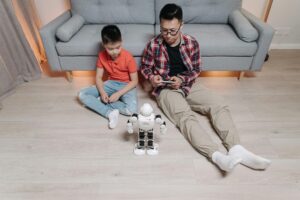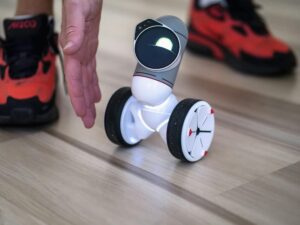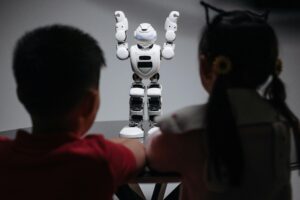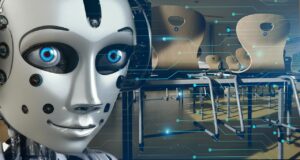New Methods for Robot Control from Single Cameras (Neural Jacobian Fields)
Introduction
Robotics has seen a rapid transformation in the last decade. From industrial automation to domestic service robots, autonomous systems are now everywhere. One of the central challenges in robotics is control—how to move a robot reliably and efficiently to achieve a task. Traditional control methods often depend on expensive sensors such as LiDAR, stereo cameras, or motion-capture systems. However, these approaches increase cost and complexity, making them less practical for everyday robotics.
A new frontier is emerging: robot control from single cameras using Neural Jacobian Fields (NJFs). This method combines the principles of differential kinematics, optimization, and deep learning to allow robots to learn how to act and interact with their environment using just monocular vision. Instead of requiring precise 3D models or multiple sensor setups, NJFs can predict how small movements of the robot’s joints translate into changes in the visual scene.
In this article, we explore the fundamentals of Neural Jacobian Fields, why they matter, how they differ from conventional control techniques, and what future possibilities they open up for robotics.
Understanding the Challenge: Why Robot Control is Hard
To appreciate the impact of Neural Jacobian Fields, it is important to understand the difficulties robots face in controlling their movements.
-
High-Dimensional Control
Most robots, such as robotic arms, drones, or humanoids, have multiple degrees of freedom (DoF). Each joint or actuator needs precise coordination to achieve a desired effect in the environment. -
Mapping Actions to Perceptions
Moving a joint by a small angle causes a change in what the robot sees. The mathematical function that maps joint movements to changes in camera pixels is known as the image Jacobian. Estimating this Jacobian accurately is essential for vision-based control. -
Dependence on 3D Models and Calibration
Traditional visual servoing requires precise camera calibration and sometimes 3D reconstruction of the environment. This is time-consuming, error-prone, and often impractical for real-world deployments. -
Dynamic and Unstructured Environments
Real-world conditions are unpredictable—lighting changes, objects move, and occlusions occur. Robots must adapt in real-time, making conventional model-based methods brittle.
This is where Neural Jacobian Fields shine—they provide a learning-based way to directly connect actions (joint changes) with perceptions (image features) without requiring explicit 3D geometry or calibration.
What Are Neural Jacobian Fields?
A Jacobian in robotics describes how small changes in joint angles affect changes in end-effector positions or, in the case of vision, how joint changes affect image pixels.
For example:
ΔI=J⋅Δq\Delta I = J \cdot \Delta q
Where:
-
ΔI\Delta I = change in image features
-
JJ = Jacobian matrix
-
Δq\Delta q = change in robot joint positions
Traditionally, estimating JJ requires precise mathematical modeling. But in Neural Jacobian Fields, this mapping is learned directly from data using deep neural networks.
Key Characteristics of NJFs
-
Learning-Based
Instead of manually computing Jacobians from camera calibration and kinematic equations, NJFs learn the mapping from visual data and robot actions. -
Field Representation
The Jacobian is not just computed at one point—it is represented as a field over the robot’s workspace. This allows smooth and continuous estimation of control mappings in different configurations. -
Generalization Across Tasks
Because NJFs learn patterns of action-perception relationships, they can generalize to new objects and tasks without needing explicit retraining for every scenario. -
Real-Time Adaptability
NJFs can be updated online, allowing robots to adjust their control strategies when the environment changes.
How Neural Jacobian Fields Work
The working pipeline of NJFs typically involves four steps:
1. Image Feature Extraction
A neural network processes the input from a monocular camera to identify relevant image features—such as object contours, keypoints, or dense pixel correspondences.
2. Action-Response Data Collection
The robot makes small, controlled movements of its joints, and the resulting changes in image features are recorded. This creates a dataset of joint-action to image-change mappings.
3. Learning the Jacobian Field
A neural network is trained to approximate the Jacobian matrix at different robot states. Instead of a single static Jacobian, the model learns a continuous Jacobian field that predicts the sensitivity of image features to joint changes across the workspace.
4. Closed-Loop Control
During operation, the robot uses the learned NJF to plan and execute movements. The control loop continuously adjusts joint actions to reduce the error between desired and observed image features.
Advantages Over Traditional Methods
-
No Camera Calibration Needed
Traditional visual servoing requires precise calibration. NJFs bypass this by learning the mapping directly from data. -
Single-Camera Operation
Instead of stereo or depth sensors, NJFs make it possible to use just one camera—reducing hardware cost. -
Robust to Uncertainty
Since the mapping is learned from data, NJFs are more resilient to noise, partial occlusions, or lighting changes. -
Task Flexibility
The same NJF framework can be applied to multiple tasks such as reaching, grasping, or manipulation without reprogramming rigid models. -
Scalability
Works for robots with many degrees of freedom, where explicit Jacobian computation would be intractable.
Applications of Neural Jacobian Fields
1. Robotic Manipulation
NJFs can guide robotic arms to pick and place objects using only camera images. This is especially useful in warehouses, factories, and household robots.
2. Drone Navigation
Small aerial robots can use NJFs to stabilize flight and navigate through cluttered environments without requiring depth sensors.
3. Medical Robotics
Surgical robots can operate in constrained environments where precise calibration is difficult, relying on NJFs to follow visual cues.
4. Humanoid Robots
For humanoids interacting with humans, NJFs can allow intuitive control based on visual features rather than rigid models.
5. Assistive Robotics
Robots assisting elderly or disabled individuals can adapt to dynamic environments by relying on NJF-based control.
Case Study: Robotic Arm Grasping with NJFs
Imagine a robotic arm tasked with picking up a cup from a cluttered table.
-
Traditional method: The robot needs the 3D model of the cup, camera calibration, and precise kinematic calculations. Any change in camera angle or object placement requires recalibration.
-
With NJFs: The robot learns how small joint movements change the view of the cup in its camera. It adjusts its movements iteratively until the end-effector aligns with the cup, all without explicit 3D modeling.
This showcases the adaptability and simplicity of the approach.
Challenges and Limitations
While Neural Jacobian Fields are promising, they are not without challenges:
-
Data Efficiency
Collecting sufficient action-response data for training can be time-consuming. -
Generalization to New Domains
Although NJFs generalize better than traditional methods, transferring them to completely unseen environments can still be difficult. -
Computation Requirements
Training neural fields requires significant compute resources, though inference is typically lightweight. -
Safety Concerns
Robots learning from trial-and-error may cause unsafe movements, especially in sensitive domains like healthcare. -
Integration with Higher-Level Planning
NJFs handle local control well but need integration with high-level planning algorithms for complex multi-step tasks.
Future Directions
The research community is actively exploring ways to improve NJFs. Some promising directions include:
-
Self-Supervised Learning
Allowing robots to collect and label their own data during operation. -
Few-Shot Adaptation
Adapting NJFs quickly to new objects and environments with minimal additional training. -
Combination with Generative Models
Using generative AI to predict possible future visual states for safer and smarter planning. -
Hardware Acceleration
Deploying NJFs on edge devices and robot-specific chips to achieve real-time control. -
Integration with Reinforcement Learning
Using NJFs as part of reinforcement learning pipelines to accelerate policy training.
Conclusion
Neural Jacobian Fields represent a paradigm shift in robot control. By leveraging single-camera input and learning-based estimation of Jacobians, they allow robots to operate more flexibly, robustly, and affordably than ever before. This innovation reduces dependence on expensive sensors and complex calibration while opening new opportunities for deployment in dynamic, real-world environments.
From robotic arms in warehouses to drones in search-and-rescue missions, NJFs have the potential to redefine how robots perceive and act in the world. While challenges remain in data efficiency, safety, and generalization, ongoing research is pushing the boundaries toward scalable, adaptive, and intelligent robotic control systems.
The future of robotics may well be powered by the elegant combination of vision, learning, and differential geometry—and Neural Jacobian Fields stand at the center of this revolution.
FAQs
Q1. What are Neural Jacobian Fields (NJFs)?
NJFs are a learning-based method for robot control that predict how changes in robot joints affect camera images, allowing robots to control movements using only monocular vision.
Q2. How do NJFs differ from traditional visual servoing?
Unlike traditional methods that require camera calibration and 3D modeling, NJFs learn the action-perception mapping directly from data, making them more adaptable and efficient.
Q3. Can NJFs work with any robot?
Yes, NJFs are generalizable and can work with robotic arms, drones, humanoids, and other systems with multiple degrees of freedom.
Q4. Are NJFs real-time?
Once trained, NJFs can be executed in real-time, though training may require significant computational resources.
Q5. What industries can benefit from NJFs?
Manufacturing, logistics, healthcare, domestic robotics, and aerospace are some of the sectors that can benefit from NJF-based control.
Q6. What are the current limitations of NJFs?
Key limitations include the need for large training datasets, difficulty in transferring across very different environments, and safety concerns during trial-based learning.
Q7. What is the future of NJFs in robotics?
Future research is focusing on self-supervised learning, better generalization, hardware acceleration, and integration with reinforcement learning to make NJFs more powerful and practical.
https://bitsofall.com/faster-methods-for-chemical-property-prediction-chemxploreml/
Decision Tree: A Complete Guide to One of the Most Powerful Algorithms in Machine Learning
Focus on Data Quality: The Foundation of Reliable Insights and AI Success







